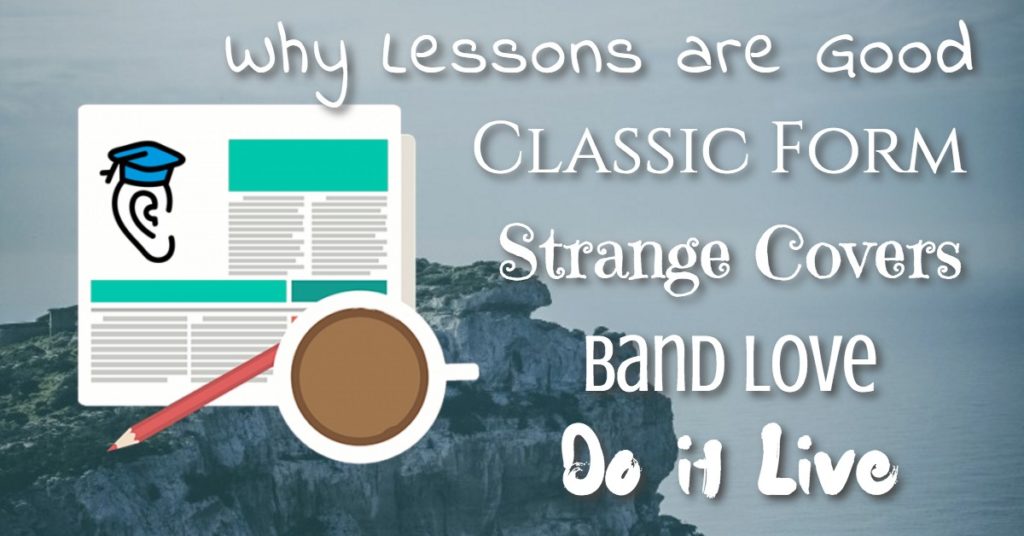Classical Music: what comes to mind? Sublime beauty? Yawnfest? Snootiness? Perfectionism? Years of training to develop totally intimidating instrumental mastery? Why is it that musicians keep performing and recording the same pieces by Haydn, Mozart, and Beethoven over and over again?
Here’s some perspective on this last question: aren’t these reinterpreted performances the same as the legions of cover songs that swarm YouTube? Aside from an explosion of classical covers of popular music (the Piano Guys or the bassoon quartet The Breaking Winds – yes, that’s their real name – come to mind) today we’ll look at more strange YouTube covers.
The truth is, when it’s good, it’s good – and we want to hear it over and over again. And even with all the online music these days, we love the live experience, knowing there’s nothing like playing music in the same room with another living breathing human being.
And what about that training? Did you know that musical training has a surprising number of benefits that go way beyond the traditional limits of a musical career?
Beyond Music: the Limitless Benefits of Musical Training
 We all love music, but how many children start out with music lessons only to quit later on? Even if you’re not going for the music career path, musical study can have amazing benefits in many surprising areas of life – including confidence, brain power, social skills and more. Randy Rogers shares his inspiring infographic portraying 6 Benefits Of Music Lessons For Kids
We all love music, but how many children start out with music lessons only to quit later on? Even if you’re not going for the music career path, musical study can have amazing benefits in many surprising areas of life – including confidence, brain power, social skills and more. Randy Rogers shares his inspiring infographic portraying 6 Benefits Of Music Lessons For Kids
The benefits of music education are difficult to assess with standardized tests. Musika considers that the intrinsic and extrinsic benefits of music education are often immeasurable.
Studies suggest that in the US over 50% of households have at least one person that plays a musical instrument, but ought that number be higher? YourMusicLessons Blog lists six reasons why kids need music lessons.
Does playing piano make children smarter? One recent study questions earlier findings, but Pianodao sets the record straight.
Classic Classical
 The thousand-year tradition of Western Classical Music includes several style periods, including The Renaissance and Baroque. But it is named after one short 70-year span from 1750 to 1820. In the Exploring Classical Music: The Classical Era, Part 1, we learned how composers crystallized the most important musical forms, which are still in use to this day. Let’s find out how the most famous composers of all time, including Ludwig van Beethoven, expanded on those forms in Exploring Classical Music: The Classical Era, Part 2
The thousand-year tradition of Western Classical Music includes several style periods, including The Renaissance and Baroque. But it is named after one short 70-year span from 1750 to 1820. In the Exploring Classical Music: The Classical Era, Part 1, we learned how composers crystallized the most important musical forms, which are still in use to this day. Let’s find out how the most famous composers of all time, including Ludwig van Beethoven, expanded on those forms in Exploring Classical Music: The Classical Era, Part 2
It’s impossible to discuss the classical music era without mentioning another one of the greatest composers of all time, Wolfgang Amadeus Mozart. Could he have been the greatest? Gramophone asked prominent Mozartians.
Classical music is all about form, including the Rondo. So what exactly is a Rondo? Classical-music.com explains.
What happens when you combine 57 famous classical tunes by 33 composers? You get a Classical Music Mash-up! See how many you can identify in Grant Woolard’s viral video.
Strange Cover Songs
Classical musicians have been covering Beethoven for more than 200 years. But YouTube has spawned a whole new breed of cover artists. Find out how amazing vocal effects combine with party toys, retro computers, and even an unbalanced washing machine to produce unforgettable musical experiences in 4 Strange Cover Songs You Have to Hear for Yourself.
 The best – or most unusual – cover songs are when artists put their own stamp on a song by someone else. Here are ten unusual cover songs, according to Best Classic Bands.
The best – or most unusual – cover songs are when artists put their own stamp on a song by someone else. Here are ten unusual cover songs, according to Best Classic Bands.
So what exactly makes a cover song weird? Or just bad? Rock It Boy has their take on the five weirdest cover songs ever.
Who says cover songs have to be weird? Here are 2016’s best cover songs, as compiled by Cover Me Songs.
Classical covers of pop tunes are all the rage. Check out this cover by a quartet of the quirkiest instrument in classical music:
Do it Live!
Yep. This is why we do it. As much as we may enjoy endless hours in the practice room going over and over those two nasty measures or that especially face-melting part of that face-melting metal riff, it’s time to bust out and share the music with someone else. Nothing compares to the experience of the real-time unfolding of the live musical moment. Whether it’s with a few friends in the living room or on the big stage, find out why Musicality Means… Performing Live.
 Playing an instrument live can be a life-changing experience. Here are Meet and Jam’s top ten benefits of playing live.
Playing an instrument live can be a life-changing experience. Here are Meet and Jam’s top ten benefits of playing live.
Never underestimate the value of a live performance. Whether it be for a small group of family and friends or a “proper” venue, The Cross-Eyed Pianist discusses the benefits of performing.
What good is it to prepare to perform live if you have nowhere to perform? Music Industry How-To explains how to get gigs in 2017 in this ultimate guide.
Wait a minute. Performing in front of people can be scary. Have no fear, Miranda Wilson, Cellist, disarms stage fright.
Build Your Team
 Wait a minute. How can you communicate your awesome music with your audience when you can’t even get along with your band mates. Yes, creating together with others has its highs, but only if you survive the lows! Our Musical U founder Christopher Sutton knows a thing or two about building a team that works well and creates together. He shares his insights on Bandzoogle with 7 Ways to Effectively Work Through Band Disagreements.
Wait a minute. How can you communicate your awesome music with your audience when you can’t even get along with your band mates. Yes, creating together with others has its highs, but only if you survive the lows! Our Musical U founder Christopher Sutton knows a thing or two about building a team that works well and creates together. He shares his insights on Bandzoogle with 7 Ways to Effectively Work Through Band Disagreements.
Feeling inspired by our articles? Ok, you’ve made it through the musical education system, have your band members all on the same page, you’re ready to record that banjo/viola cover of the opening scene of Mozart’s Don Giovanni. Butter up some popcorn, invite over a few friends and do it live!







